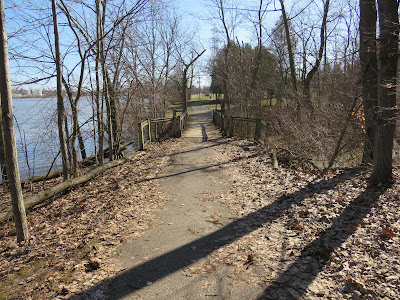Back in Michigan, I begin my morning hike in Alma’s Conservation Park where the sky is sunny, the air is a chilly, 32 degrees along with a gusty north wind. After passing a singing Song Sparrow, I proceed west along a green-less bank of the Pine River. Up ahead, I spot a male and female Wood Duck perched high on a tree branch. These ducks are unique among most waterfowl in that they need bodies of water that are near woodlands so they can nest in tree cavities. The male is one of the most stunningly attractive of all waterfowl with plumage of iridescent chestnut and green as well as ornate patterns on nearly every feather (stock photo). Unlike most waterfowl, this mating pair is at home high in the trees. Their webbed feet are tipped with sharp claws that allow for easy perching, and their broad wings and tail allow them to easily navigate as they fly through dense woods. The Wood Duck is the only North American duck that regularly produces two broods in one year. Suddenly, they fly off as the female makes its familiar high-pitched squealing call. Proceeding south away from the river, I approach the Girl Scout Cabin where my ears perk up to the sound of a Robin and my eyes are drawn to a Northern Flicker foraging on the lawn. On the rain-saturated ground nearby, I see a few puddles covered with ice which reminds me this is springtime in Michigan, not southern California. Working my way along the south boundary of the park, I hear one variation of a Cardinal song, followed by another. Turning east, I follow an earthen trail through a dense, coniferous woodland where I pause to listen to a drumming Downy Woodpecker, followed by a faint response from another one in the distance. Many birds sing to advertise their presence and attract a mate. Woodpeckers drum, rapidly pecking their bills against resonant objects to announce their availability to prospective mates. In the forest they seek out dead trees and hollow logs to produce this percussive hammering sound. A sound quite different than the irregular pecking made when they are feeding. Next, I proceed toward the Eyer Learning Circle where I have a stare-down with a Whitetail deer. After checking out the kiosk displays at the circle, I wander over to the bird feeders in time to see several Dark-eyed Juncos, foraging on the ground. Like many other birds, Juncos migrate “South” for the winter months; however, lower Michigan is their “South.” Soon, they will begin a northerly migration to their summer breeding grounds in Canada.
Perching squirrels
Chitter, Chatter
Chipmunks run
Pitter, patter
Wood duck pair
Fly and squeak
Rushing river
Babbling creek
Frogs and toads
Start to sing
Nature’s choir
Hymns of spring
D. DeGraaf

Cold morning here! You saw a lot of familiar birds today!
ReplyDeleteI love those last 4 lines, especially.
ReplyDelete